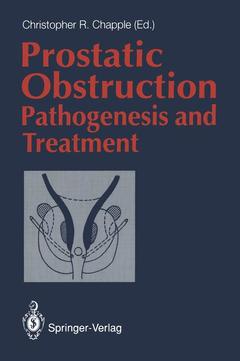Prostatic Obstruction, Softcover reprint of the original 1st ed. 1994 Pathogenesis and Treatment
Langue : Anglais
Coordonnateur : Chapple Christopher R.

The human prostate gland is of undoubted importance in reproductive physiology and is one of the commonest causes of clinical urological problems in the male patient. Despite the wealth of published lit erature relating to the prostate gland surprisingly little is understood about its neural innervation, the influence of pharmacological factors and its precise physiological functions. Indeed, benign disorders of the prostate gland including benign prostatic hyperplasia, bladder neck dyssynergia and inflammatory disorders of the prostate (prostatitis, prostatodynia) although well recognised clinically, are as yet poorly characterised and understood. It was not until the late 1960s that the subject of urodynamics, which for the first time allowed scientific assessment of the function of the lower urinary tract, was introduced. The first section of this book considers recent advances in our understanding of the innervation of the bladder and prostate gland and the changes in bladder function which accompany prostate medi ated bladder outflow obstruction. The clinical consequence of benign prostatic hyperplasia in many patients is bladder outflow obstruction and although the traditional treatment of these conditions is by the use of ablative surgery, in recent years a number of new modalities have been investigated and are reviewed in the second section of the book.
Section A: The Importance of Neural Factors in the Presentation and Treatment of Prostatic Obstruction.- 1 Introduction: The Clinical Problem.- Historical Review.- Urodynamic Investigation.- Prostate Obstruction and Detrusor Instability.- The Neural Control of the Human Prostate: Neural Influences and Benign Prostatic Hyperplasia.- 2 The Anatomy and Innervation of the Bladder.- Historical Aspects.- Anatomy.- Innervation.- Motor Innervation.- Sensory Innervation.- Summary.- 3 The Physiology of Micturition.- Neurophysiological Control of the Bladder.- Local Neural Pathways.- Reflexes Governing Micturition.- Pharmacological Responses of the Bladder.- The Role of the Parasympathetic Nervous System.- The Role of the Sympathetic Nervous System.- The Role of Non-adrenergic, Non-cholinergic.- Neurotransmission.- Summary.- 4 Pathophysiological Changes in the Obstructed Bladder.- A Review of Previous Experimental Animal Studies.- Human Studies.- A Clinical Study of the Pathogenesis of Detrusor Instability in the Obstructed Bladder.- Summary.- 5 Anatomy and Innervation of the Prostate Gland.- Anatomy.- Innervation.- Section B: Contemporary Management of Bladder Outflow Obstruction.- 6 Bladder Outflow Obstruction in the Male.- Detrusor Function and Dysfunction.- Normal Bladder Function.- Instability and Myth of “Prostatism”.- Detrusor Response to Obstruction.- Response of Unstable Detrusor Symptoms to the Relief of Obstruction.- The Cause of Unstable Detrusor Behaviour in Male Bladder Outflow Obstruction.- Should the Natural Age-Related Diminution of the Voiding Flow be Regarded as Normal?.- Bladder Neck Obstruction.- Bladder Outflow Obstruction and “Relative Obstruction”.- Voiding Inefficiency.- Normal Bladder Neck Function.- Bladder Neck Dyssynergia.- Symptoms and Presentation of Dyssynergic.- Bladder Neck Obstruction.- Secondary Symptoms.- Prostatitis and the Dyssynergic Bladder Neck.- Synergic Bladder Neck Obstruction: Detrusor Dysfunction.- Diagnosis of Dyssynergic Bladder Neck Obstruction 89.- Indications for the Treatment of Dyssynergic Bladder Neck Obstruction.- Effective Relaxation of the Dyssynergic Bladder Neck by Endoscopic Incision.- The Relationship of Prostatic Enlargement to the Normal Bladder Neck Mechanism.- The Relationship of Prostatic Enlargement to the Dyssynergic Bladder Neck Mechanism.- Double Obstruction: The Combination of Prostatic and Dyssynergic Bladder Neck Obstruction - The “Trapped Prostate”.- Development of Secondary Bladder Neck Contracture after Loop Resection of a Double Obstruction.- Treatment of Double Obstruction by Combined Endoscopic.- Incision and Loop Resection.- Conservative Surgery of Double Obstruction.- The “Small Fibrous Prostate”.- Summary: The Three Appearances of the Proximal Posterior Urethra and their Appropriate Treatment in Proven Outflow Obstruction.- Conclusion.- 7 The Investigation of Benign Prostatic Hyperplasia.- The Bladder.- Standard Investigations.- Upper Tract Assessment.- Investigation of Bladder Function.- Frequency-Volume Chart.- Pad Testing.- Uroflowmetry.- Ultrasound Cystodynamogram (USCD).- Cystometry.- Urethral Pressure Profile.- Benign or Malignant Prostatic Disease?.- 8 The Complications of Prostatectomy.- Anaesthetic complications in the Elderly male.- Risks of Surgery and Anaesthesia.- Overall Risks of Mortality During Anaesthesia and Surgery.- Risk of Cardiac Arrest During Surgery.- Risk of Myocardial Infarction During Surgery.- Risks of General Anaesthesia in the Elderly Male.- Central Nervous System.- Cardiovascular System.- Respiratory System.- Complications of General Anaesthesia Specific To TURP.- Regional Anaesthesia.- Cardiovascular Effects.- Respiratory System.- Other Complications.- Summary.- Complications of Prostatectomy.- Mortality of Prostatectomy.- Mortality of Open Prostatectomy.- Mortality of TURP.- Morbidity of TURP.- Long-Term Morbidity.- Peroperative Complications of TURP.- Trauma.- Haemorrhage.- Irrigation Fluid Loading and the TUR Syndrome.- Risks to the Surgeon.- Prophylactic Measures in Prostatectomy Patients.- The Recovery Room and Ward.- Other Physiological Disturbances Caused by TURP.- Thermodynamics, Hypothermia and TURP.- Acute Haemodynamics of TURP.- Conclusion.- 9 Prostate Stents.- Prostate Stents.- Temporary Stents.- Permanent Stents.- Experimental Work.- Clinical Experience.- Prostate Obstruction.- Results.- Stent Removal.- Other Permanent Prostate Stents.- Indications for Prostate Stents.- Other Indications for Urethral Stents.- Future Developments.- Conclusion.- 10 Prostatic Hyperthermia.- Local Prostatic Hyperthermia.- Transrectal Microwave Hyperthermia.- Transurethral Microwave Hyperthermia.- Conclusion.- 11 Balloon Dilatation of the Prostate.- History of Prostate Dilatation.- Techniques.- Patient Selection.- Mechanism of Action.- Results.- Complications.- Summary.- 12 Is Pharmacotherapy a Satisfactory Alternative Treatment for Benign Prostatic Hyperplasia?.- Hormonal Therapy.- Adrenergic Blockade.- Experimental Studies.- Functional Muscle Strip Studies.- Radioligand Binding Studies: Homogenates.- Radioligand Binding Studies: Slide-Mounted Tissue Sections.- Conclusions.- Clinical Studies.- Conclusions.- The Future.- Laboratory Studies.- Clinical Studies.- 13 Bladder Neck Dyssynergia and Prostatitis.- Bladder Neck Dyssynergia.- Bladder Neck Function.- Clinical Features.- Investigation.- Treatment.- Summary.- Prostatitis.- Pathogenesis.- Clinical Features.- Investigations.- Treatment.- Summary.
Date de parution : 12-2011
Ouvrage de 234 p.
15.5x23.5 cm
Disponible chez l'éditeur (délai d'approvisionnement : 15 jours).
Prix indicatif 52,74 €
Ajouter au panierThème de Prostatic Obstruction :
© 2024 LAVOISIER S.A.S.



